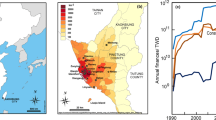Summary
Atmospheric lead levels were examined to assess the consequences of the 46 percent reduction in the lead content of premium grade petrol in New Zealand. Since this change was implemented in July 1986 observed levels of atmospheric lead decreased by 38 percent, but all or part of this reduction may have been due to factors other than fluctuations in lead emissions, notably variations in climate. Analysis of detailed atmospheric lead, meteorological and traffic data measured contemporaneously provided insight into the atmospheric processes influencing lead levels in Auckland and formed the basis of a statistical model capable of predicting monthly lead concentrations. The model was used to predict lead levels in Auckland for the period July 1986 through to July 1989 in the absence of any reduction in the lead content of petrol. Comparison with values observed for the same period showed that all of the reduction in atmospheric lead levels since July 1986 can be attributed to the reduction in the lead content of petrol. Policy planning implications of such a finding are considered.
Similar content being viewed by others
References
Bowman, H. R., Conway, J. G., Asaro, F., 1972: Atmospheric lead and bromine concentration in Berkeley, California (1963–1970).Environmental Science and Technology 6, 558–560.
Campbell, S. J., 1986: Investigations into organolead compounds in the New Zealand atmosphere. MSc Thesis, Chemistry Department, University of Auckland, New Zealand.
Chamberlain, A. C., Heard, M. J., Little, P., Wiffen, R. D., 1979: The dispersion of lead from motor exhausts.Phil. Trans. Roy. Soc. London A290, 577–589.
Chow, T. J., Earl, J. L., 1970: Lead aerosols in the atmosphere.Science 169, 577–580.
Clark, W. A. V., Hosking, P. L., 1986:Statistical Methods for Geographers. New York: Wiley and Sons, 518 pp.
Colucci, J. M., Begeman, C. R., Kumler, K., 1969: Lead concentrations in Detroit, New York, and Los Angeles air.J. Air Pollution Control Association 19, 255–260.
Day, J. P., 1977: Lead pollution in Christchurch.New Zealand J. Science 20, 395–406.
Edwards, H. W., Wheat, H. G., 1978: Seasonal trends in Denver atmospheric lead concentrations.Environmental Science and Technology 12, 687–692.
Esmen, N. Z., Corn, M., 1971: Residence time of particles in urban air.Atmos. Environ. 5, 571–578.
Goodman, H. S., Noller, B. N., Pearman, G. I., Bloom, H., 1976: The heavy metal composition of atmospheric particulates in Hobart, Tasmania.Clean Air 10, 38–41.
Graham, B. W. L., 1984: Lead pollution in Auckland, New Zealand: airborne particulate matter.New Zealand J. Science 27, 327–336.
Hirschler, D. A., Gilbert, L. F., 1964: Nature of lead in automobile exhaust gas.Arch. Environ. Health 8, 297–312.
Hoggan, M. C., Davidson, A., Brunelle, M. F., Nevitt, J. S., Gins, J. D., 1978: Motor vehicle emissions and atmospheric lead concentrations in the Los Angeles area.J. Air Pollution Control Association 28, 1200–1206.
Huntzicker, J. J., Friedlander, S. K., Davidson, C. I., 1975: Material balance for automobile-emitted lead in Los Angeles basin.Environmental Science and Technology 9, 448–457.
Hurnard, S. M., 1980:Auckland's Climate. Wellington: New Zealand Meteorological Service, Misc. Publ. 161 (1), 10 pp.
Jones, R. R., Stephens, R., 1983: The contribution of lead in petrol to human lead intake. In: Rutter, M., Jones, R. (eds.)Lead Versus Health. New York: Wiley & Sons, pp. 141–177.
Mallows, C. L., 1964: Some comments onC p.Technometrics 15, 661–675.
National Academy of Sciences, USA, 1971:Airborne Lead in Perspective. Committee on Biologic Effects of Atmospheric Pollutants, Division of Medical Sciences, National Research Council, Washington, D.C.
New Zealand Meterological Service, 1981:Summaries of Climatological Observations to 1980. Wellington: Misc. Publ. 177, 172 pp.
O'Connor, B. H., Allen, G. H., 1980: Variation in airborne particulate lead concentration at two stations in Perth, Western Australia (1974–76).Clean Air 14, 3–7.
O'Connor, B. H., Hammond, L. C., Cameron, I., Martin, D. J., Powell, R., 1989: Variation in atmospheric particulate lead and total suspended particulate concentrations for Perth, Western Australia (1982–1987).Clean Air (in press).
O'Connor, B. H., Kerrigan, G. C., Nouwland, C. R., 1978: Temporal variation in atmospheric particulate lead and bromine levels for Perth, Western Australia (1971–76).Atmos. Environ. 12, 1907–1926.
Pocock, S. J., Ashby, D., 1985: Environmental lead and children's intelligence: a review of recent epidemiological studies.Statistician 34 (1), 31–44.
Royal Commission on Environmental Pollution, 1983: Ninth Report,Lead in the Environment. London HMSO, 184 pp.
Simmonds, P. R., Tan, S. Y., Fergusson, J. E., 1983: Heavy metal pollution at an intersection involving a busy urban road in Christchurch, New Zealand, 2 Aerosol lead levels.New Zealand J. Science 26, 229–242.
Smith, M., 1985: Recent work on low level lead exposure and its impact on behaviour, intelligence, and learning.J. Am. A. Chil. 24, 24–32.
Steiner, J. T., Clarkson, T. S., 1985: Heavy metals in the New Zealand atmosphere.J. Roy. Soc. New Zealand 15 (4), 389–398.
Taylor, B., 1990: Lead in petrol. Proceedings from the ‘Lead in the Environment’ Seminar, University of Auckland, August, 1988 (in press).
U.K. Department of the Environment, 1974: Lead in the environment and its significance to man. Report of an interdepartmental working group on heavy metals. London: HMSO, 46 pp.
United States Environmental Protection Agency, 1983:Air Quality Criteria for Lead, Vol. 2, EPA-600/8-83/028B. Springfield VA, NTIS, 300 pp.
Watson, J. G., Chow, J. C., Shah, J. J., Pace, T. G., 1983: The effect of sampling inlets on the PM-10 and PM-15 to TSP concentration ratios.J. Air Pollution Control Association 33, 114–119.
Witz, S., Larm, A. M., Elvin, B. M., Moore, A. B., 1982: The relationship between concentration of traffic-related pollutants and meteorology at a Los Angeles site.J. Air Pollution Control Association 32, 643–645.
Witz, S., Moore, A. B., 1981: Effect of meteorology on the atmospheric concentrations of traffic-related pollutants at a Los Angeles site.J. Air Pollution Control Association 31, 1098–1101.
Author information
Authors and Affiliations
Additional information
With 7 Figures
Rights and permissions
About this article
Cite this article
Power, H.C., de Freitas, C.R. & Hay, J.E. Relative effects of climate and source strength on atmospheric lead concentrations in Auckland, New Zealand. Theor Appl Climatol 45, 127–138 (1992). https://doi.org/10.1007/BF00866401
Received:
Revised:
Issue Date:
DOI: https://doi.org/10.1007/BF00866401




